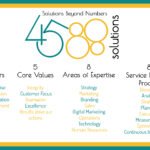
Understanding Insight-Driven Strategy
In today’s rapidly evolving business landscape, an insight-driven strategy has become a crucial component for organizations aiming to thrive and adapt. An insight-driven strategy encompasses the process of utilizing data and analytical insights to shape and inform key business decisions. By leveraging data analytics, businesses can extract meaningful insights that support strategic planning and drive growth.
To implement an effective insight-driven strategy, organizations must identify various types of data that can provide valuable context and inform their decisions. Customer feedback plays a significant role, as it allows businesses to understand consumer preferences, behaviors, and pain points. By analyzing this data, companies can tailor their products and services to better align with market demand. Furthermore, incorporating market trends into the analysis enables businesses to stay ahead of competitors by identifying emerging patterns and potential opportunities within their industry.
Operational metrics are another essential element of data analysis that contribute to an insight-driven strategy. By examining internal processes, organizations can pinpoint inefficiencies and areas for improvement, ultimately leading to better resource allocation and enhanced operational performance. Transforming raw data into actionable insights is imperative; this often involves employing data visualization techniques and analytical tools that facilitate a clearer understanding of complex information.
As businesses embrace an insight-driven approach, they gain the ability to make informed decisions that impact their strategic direction. This ultimately leads to more effective business strategies and an overall increase in growth potential. By continuously refining their analytic capabilities and prioritizing data sources, organizations are better equipped to adapt to changing market conditions and consumer expectations.
The Role of Data Analytics in Business Growth
Data analytics has increasingly become the cornerstone of an insight-driven strategy, particularly pivotal in fostering growth within businesses. In an era characterized by massive data generation, organizations leverage various analytical methods and tools to transform raw data into actionable insights. Techniques such as descriptive, diagnostic, predictive, and prescriptive analytics are fundamental for businesses looking to harness their data effectively. Descriptive analytics helps in understanding historical data trends, while diagnostic analytics provides insights into the factors contributing to those trends. Predictive analytics gives organizations the foresight to anticipate future outcomes, and prescriptive analytics offers recommendations on how to optimize decisions.
Leveraging advanced tools such as Tableau, Power BI, and IBM Watson Analytics enables businesses to visualize and interpret data seamlessly, turning complex information into digestible insights. These platforms empower stakeholders to analyze vast datasets, ensuring that strategic decisions are data-driven rather than based on intuition alone. A case in point is the retail giant Amazon, which utilizes sophisticated analytics to personalize customer experiences, effectively increasing sales and maintaining customer loyalty. By analyzing purchasing patterns and feedback, Amazon tailors its offerings to meet specific customer needs, thereby driving growth.
Another exemplary case is Starbucks, which employs data analytics to enhance customer experience and optimize inventory management. Through its loyalty card program, the company collects data on customer preferences and behaviors, allowing it to provide personalized promotions and improve service efficiency. This insight into consumer behavior not only boosts customer satisfaction but also contributes to operational efficiency, leading to overall business growth.
Incorporating data analytics into the core business strategy not only enhances decision-making capabilities but also drives continuous improvement across all functions. Organizations committed to using data analytics as a foundation for their strategies can expect to experience increased sales, operational efficiencies, and improved customer interactions, all of which are critical elements in the pursuit of sustainable growth.
Implementing Insight-Driven Strategies
For organizations looking to harness the power of data analysis to fuel growth, implementing insight-driven strategies requires a thorough approach that is both structured and adaptable. Firstly, fostering an organizational culture that prioritizes data-driven decision-making is essential. This shift involves promoting a mindset where data is not just a tool but a foundational element for strategy development. Leaders should champion this culture by demonstrating the value of insights derived from data analysis in guiding key business decisions.
Next, cross-departmental collaboration plays a critical role in the successful implementation of insight-driven strategies. By breaking down silos between departments, organizations enable a richer exchange of information and ideas. Teams from varying functions—such as marketing, sales, and finance—must work together to understand how their unique insights can contribute to a unified business strategy. Regular interdepartmental meetings and collaborative projects can enhance synergy and ensure that all perspectives are taken into account when crafting strategy.
Moreover, the role of technology cannot be overstated in gathering and analyzing relevant data. Investing in advanced analytics tools and platforms allows businesses to efficiently process large volumes of information and extract actionable insights. Organizations should provide training to their employees on using these technologies effectively, ensuring that every team member is equipped to contribute to the overall strategy through informed insights.
As organizations embark on this journey, it is vital to remain vigilant against common pitfalls. These may include over-reliance on data without critical analysis, neglecting qualitative insights, and failing to adapt strategies in response to changing market conditions. By adhering to a few practical tips, such as regularly reviewing strategy efficacy and encouraging a feedback loop throughout the organization, businesses can ensure they remain aligned with their growth objectives through data-driven insights.
Measuring Success: Key Performance Indicators
In the realm of data analysis, the use of Key Performance Indicators (KPIs) serves as a pivotal tool for businesses seeking to evaluate the effectiveness of their strategies. These metrics provide quantifiable measures that align closely with a company’s objectives, effectively guiding firms in understanding their performance and aiding in decision-making processes. As companies endeavor to transform data into actionable insights, tracking the right KPIs is essential for fostering growth and ensuring sustained competitiveness in the marketplace.
One critical metric that businesses need to monitor is customer acquisition cost (CAC). This KPI measures the total cost of acquiring a new customer, including marketing expenses and sales resources. By analyzing this data, firms can ascertain the efficiency of their marketing strategies, allowing them to allocate resources more effectively and streamline their efforts for optimal impact. Another essential metric to consider is the conversion rate, which indicates the percentage of potential customers who take desired actions, such as completing a purchase or signing up for a newsletter. High conversion rates generally reflect successful engagement strategies, while conversely, low rates can signal the need for strategic revisions based on data-driven insights.
Retention metrics also play a crucial role in evaluating business health. By tracking customer churn rates—how many customers stop doing business with a company—organizations can gain insights into customer satisfaction and loyalty. Retaining existing customers is typically more cost-effective than acquiring new ones, making it imperative for businesses to maintain a strategic focus on enhancing the customer experience. Continuous monitoring of these KPIs empowers organizations to adapt their strategies in real-time, thus ensuring that they are on the right trajectory toward growth. Regular analysis, coupled with an agile approach to strategy modification, reinforces a company’s ability to respond to market changes, thereby securing its competitive advantage.


